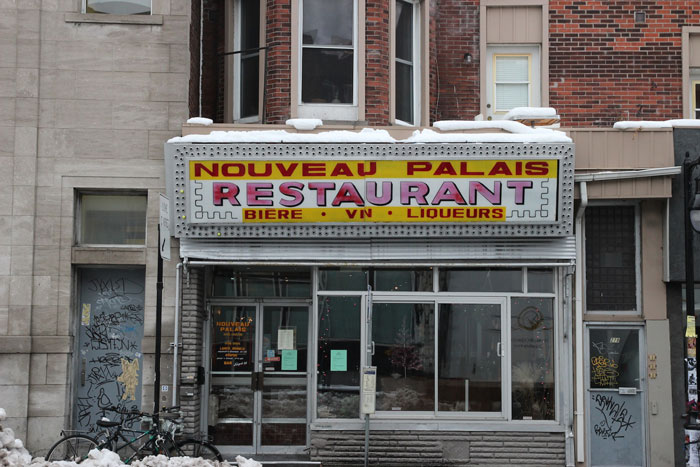The Signs of Gentrification

Photograph by Jason Harvey.
Mile End is gentrifying, gentrifying, almost all-the-way gentrified. Since the eighties, when the Montreal neighbourhood became known as a cheap refuge for artists and musicians, the changes have come inexorably–most recently, in the form of shiny new signage. After Cafe Navarino's facelift, in 2010, the local landmark’s rusted 1960s-style sign disappeared. Save for the letters B-A-R above the front door, the swanky Bar Waverly is nearly unrecognizable as the former location of the dive Bar St. Laurent 2. But when Jacques Seguin and Marie Martha Campbell bought the restaurant Nouveau Palais, located on Bernard, not far from either Navarino or Waverly, they vowed to keep its vintage front intact.
“It’s a beautiful sign. It represents an era when Montreal had a lot of signs like that,” says Seguin. Retro bulbs adorn its border, and yellow-and red-letters spell out “Restaurant” in block type much larger than that of the restaurant’s actual name. “The neighbourhood is really attached to it,” adds Seguin. I know I’m not the only one who has hazy, alcohol-induced memories of being drawn to that sign like a moth to a flame, ordering a steamie or a fried-egg sandwich at four in the morning. Perhaps of the appeal of the retro sign is that it helps generate this nostalgia.
But the new owners faced a challenge: a Montreal by-law concerning visual pollution. The sign was too big and bright, and stuck out too much, for new regulations regarding signage that came into effect in 2006. These rules, however, only apply when a restaurant changes hands. When word spread that the new owners might have to change the gem, I remember one commenter on the now-defunct Stillepost discussion board stressing that Nouveau Palais’ sign was “the whole point.”
Seguin and Campbell applied to the city for an exception to the by-law on the basis that the sign was an aesthetic landmark, one with historic importance to the neighbourhood. They became the second restaurant, following Le Fameux on the corner of Mont Royal and St. Denis, to have such a request granted. And so the greasy-spoon-turned-less-greasy-spoon—today, Nouveau Palais features upscale comfort food and DJ nights—was able to keep its sign. It references the grittiness, the tackiness, the authenticity of the old Nouveau Palais, the one with terrible food and career waitresses—the neighbourhood institution where you could fall asleep at the table and no one would kick you out.
Nouveau Palais’ is not the only story of change and borrowing. As gentrification creeps eastward across Brooklyn, swallowing up Williamsburg and Park Slope, it is spilling over into neighbourhoods like Bedford-Stuyvesant. The result is me, a white grad student, living in a hood that rappers like Biggie and Jay-Z repped not so long ago. Near my apartment, there’s a hip restaurant that has kept the facade of the West Indian joint that preceded it. On the front doors, the new owners scrawled a minimalist “Do or Dine,” the new name, obscured for the most part by the faded awning of the previous establishment.
I noticed a similar instance of cultural appropriation when I was living in a Toronto neighbourhood that also faced aggressive gentrification. The Ossington strip between Queen and College is developing so rapidly that, until last summer, the city put a freeze on new bars and restaurants; today, a club in the area has only the sign, in Vietnamese, from the restaurant that was once there. Its characters are illegible to its target clientele. Both the sign in Brooklyn and the one in Toronto give the new establishments an added boost of cultural cachet. The spots don't need to even advertise their existence; instead, they rely on Yelp reviews and word-of-mouth among their uber-hip clientele.
But this phenomenon isn’t limited to white-bread spots copping the exoticism of immigrant joints. It can happen the other way around. In the eighties, when Subodh Mathur moved to Ottawa, he didn’t have the money to change the signage of Rose’s Cafe, and so Rose’s Cafe (the tea house) became Rose’s Cafe (the Indian restaurant). The place was so successful that it became a franchise. Today, Mathur no longer has a hand in any of these establishments, but there are still several Rose’s Cafe restaurants around the city.
Appropriation is usually a dirty word, and for good reason. But while appropriating Asian characters to make your club seem hip is problematic in obvious ways, there’s something else happening as well. These anachronistic signs make visible what the force of gentrification makes invisible in so many other ways. They are a reminder of what used to be here—what is here no longer. They are a visual ethnography of the neighbourhood, sign on top of sign, layer on top of layer, regardless of whether the change is driven by white hipsters taking over a racialized Brooklyn neighbourhood or by a wave of immigration to Canada’s capital.
It’s gone now, but there used to be a Jewish bakery in Montreal that re-painted its sign in the 1970s, changing it from English to French following the requirements of Bill 101. After many years of sun and snow, the topcoat started fading. At one point, you could read both layers, the two periods of Montreal's history, superimposed on top of one another.
An earlier version of this article misidentified the street on which Nouveau Palais is located. Maisonneuve regrets the error.
Subscribe to Maisonneuve today.
Related on maisonneuve.org:
—Alphabet City
—Navarino Cafe: A Love Letter
—The Rise of Voodoo Gentrification





